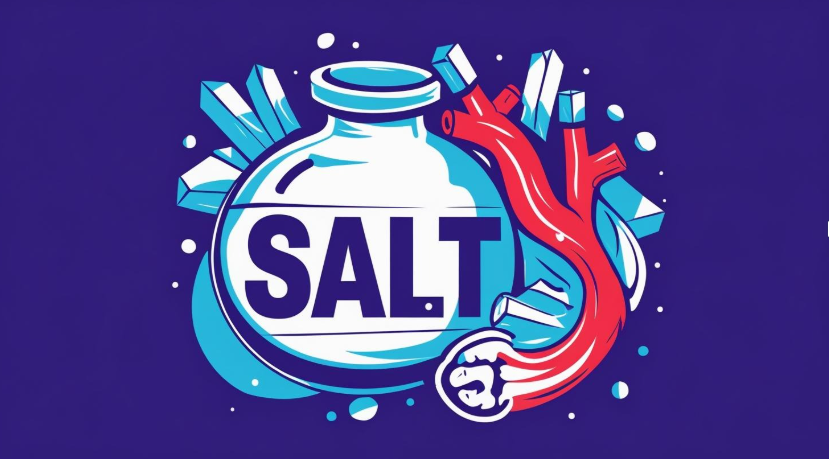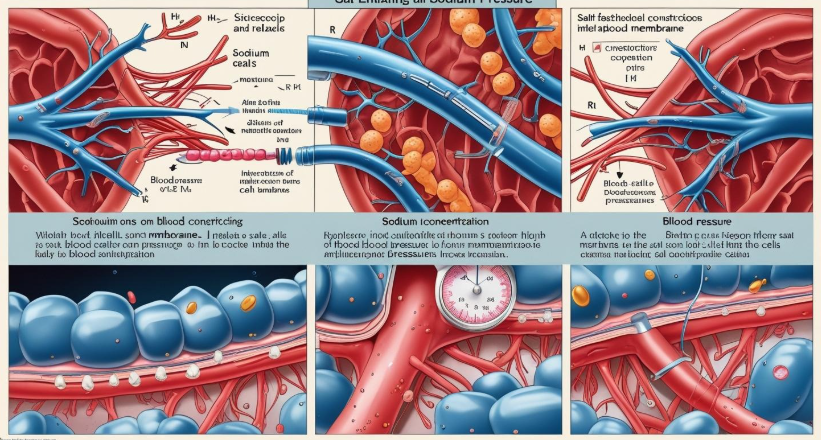Salt is a vital mineral in our diet, but too much of it can be harmful. The relationship between salt and blood pressure is one of the most well-documented in modern health science. While salt enhances flavor and helps with food preservation, excessive salt intake is a major contributor to hypertension, also known as high blood pressure.
In this article, we’ll dive deep into how salt and blood pressure are connected, the science behind sodium’s impact on the body, and practical tips to maintain a heart-healthy lifestyle.

What Is Blood Pressure?
To understand the relationship between salt and blood pressure, we first need to understand what blood pressure is. Blood pressure is the force of blood pushing against the walls of your arteries as your heart pumps. It is expressed as two numbers:
- Systolic pressure (the top number) measures the pressure during heartbeats.
- Diastolic pressure (the bottom number) measures the pressure between beats.
A normal blood pressure reading is around 120/80 mmHg. When your blood pressure stays elevated for a long time, it leads to hypertension — a condition that increases the risk of heart disease, stroke, and kidney damage.

How Salt Affects Blood Pressure
Now let’s break down how salt affects the body and why salt and blood pressure are so closely linked.
- Fluid Retention
When you consume too much salt, your body retains more water to dilute the sodium in your bloodstream. This added volume of fluid increases the pressure on your blood vessels, which raises blood pressure. - Increased Blood Volume
More fluid in your blood means a greater blood volume. This puts added stress on your heart and arteries. - Artery Stiffening
Long-term high salt intake can cause your blood vessels to become less flexible, which contributes to higher blood pressure and heart strain. - Kidney Damage
Your kidneys play a vital role in regulating sodium. Too much salt can damage the kidneys, making it harder to remove excess sodium from the body. This creates a dangerous cycle between salt and blood pressure.
Scientific Evidence Supporting the Link
The connection between salt and blood pressure is supported by a vast body of research. According to the World Health Organization, reducing salt intake is one of the most effective ways to prevent high blood pressure and cardiovascular disease.
A study published by the Centers for Disease Control and Prevention (CDC) shows that people who reduce their sodium intake have significantly lower blood pressure, regardless of age or existing health conditions.
🔗 CDC: Sodium and Blood Pressure
How Much Salt Do You Need?
Most people only need about 1,500 to 2,300 mg of sodium per day — that’s less than one teaspoon of table salt. However, the average person consumes nearly 3,400 mg of sodium daily, according to the American Heart Association (AHA).
This excess contributes to the global rise in hypertension and heart disease, showing how dangerous the combination of salt and blood pressure can be.
Who Is Most Sensitive to Salt?
Salt affects people differently. Some individuals are more salt-sensitive, meaning their blood pressure rises more dramatically with high sodium intake.
- Elderly individuals
- People with African or South Asian descent
- Those with hypertension, kidney disease, or diabetes
- Genetically predisposed individuals
Even if you’re not salt-sensitive, reducing salt intake is beneficial, as the link between salt and blood pressure applies universally.
Hidden Sources of Salt in Food
Most people associate salt with what they add during cooking or at the table. However, about 70% of sodium comes from processed and packaged foods.
Common hidden sources include:
- Bread and baked goods
- Canned soups
- Frozen meals
- Deli meats and sausages
- Cheese and condiments
Be sure to check nutrition labels. Even “healthy” or “low-fat” foods can be high in sodium, which continues to fuel the connection between salt and blood pressure.
Tips to Reduce Salt and Control Blood Pressure
Here are some effective ways to manage your salt intake and protect your heart health:
1. Read Labels Carefully
Check sodium content per serving. Aim for products with less than 140 mg of sodium per serving.
2. Cook More at Home
Home-cooked meals give you control over ingredients, reducing your exposure to added salt and allowing you to manage salt and blood pressure more effectively.
3. Use Alternatives
Use herbs, lemon, garlic, and spices to enhance flavor instead of salt.
4. Choose Fresh Over Processed
Fresh fruits, vegetables, whole grains, and lean proteins typically contain less sodium.
5. Limit Sauces and Condiments
Soy sauce, ketchup, and salad dressings often contain high amounts of salt. Choose low-sodium versions when available.

Benefits of Lowering Salt Intake
Reducing salt intake has immediate and long-term benefits:
- Lower blood pressure
- Reduced risk of stroke and heart attack
- Improved kidney function
- Better overall health
Even a small reduction in daily sodium can make a big difference in controlling salt and blood pressure outcomes.
Government and Health Initiatives
Many governments are working to reduce sodium in the food supply. For example, the UK Salt Reduction Program showed significant success in reducing average salt consumption and improving public health outcomes.
🔗 UK Salt Reduction Success Story – BMJ
Similarly, in the United States, the FDA has issued voluntary sodium reduction targets for food manufacturers to help lower national sodium intake.
These initiatives show that addressing salt and blood pressure on a population level is both possible and impactful.
Final Thoughts: Take Control Today
The link between salt and blood pressure is too important to ignore. High salt intake leads to higher blood pressure, which in turn raises the risk of heart disease, stroke, and premature death. The good news is that reducing salt in your diet is a simple yet powerful step toward better health.
By becoming more aware of how much sodium you’re consuming and making small changes to your eating habits, you can protect your heart and live a healthier, longer life.